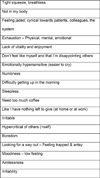"It Is Like Heart Failure. It Is Chronic … and It Will Kill You": A Qualitative Analysis of Burnout Among Hospice and Palliative Care Clinicians
- PMID: 28063867
- PMCID: PMC5410187
- DOI: 10.1016/j.jpainsymman.2016.12.337
"It Is Like Heart Failure. It Is Chronic … and It Will Kill You": A Qualitative Analysis of Burnout Among Hospice and Palliative Care Clinicians
Abstract
Context: Although prior surveys have identified rates of self-reported burnout among palliative care clinicians as high as 62%, limited data exist to elucidate the causes, ameliorators, and effects of this phenomenon.
Objectives: We explored burnout among palliative care clinicians, specifically their experiences with burnout, their perceived sources of burnout, and potential individual, interpersonal, organizational, and policy-level solutions to address burnout.
Methods: During the 2014 American Academy of Hospice and Palliative Medicine/Hospice and Palliative Nurses Association Annual Assembly, we conducted three focus groups to examine personal narratives of burnout, how burnout differs within hospice and palliative care, and strategies to mitigate burnout. Two investigators independently analyzed data using template analysis, an inductive/deductive qualitative analytic technique.
Results: We interviewed 20 palliative care clinicians (14 physicians, four advanced practice providers, and two social workers). Common sources of burnout included increasing workload, tensions between nonspecialists and palliative care specialists, and regulatory issues. We heard grave concerns about the stability of the palliative care workforce and concerns about providing high-quality palliative care in light of a distressed and overburdened discipline. Participants proposed antiburnout solutions, including promoting the provision of generalist palliative care, frequent rotations on-and-off service, and organizational support for self-care. We observed variability in sources of burnout between clinician type and by practice setting, such as role monotony among full-time clinicians.
Conclusion: Our results reinforce and expand on the severity and potential ramifications of burnout on the palliative care workforce. Future research is needed to confirm our findings and investigate interventions to address or prevent burnout.
Keywords: Burnout; focus groups; health workforce; palliative care; qualitative research; resilience.
Copyright © 2017 American Academy of Hospice and Palliative Medicine. Published by Elsevier Inc. All rights reserved.
Figures
Comment in
-
I Never Thought "That Person" Could Be Me ….J Pain Symptom Manage. 2017 Jul;54(1):e3-e5. doi: 10.1016/j.jpainsymman.2017.02.002. Epub 2017 Feb 24. J Pain Symptom Manage. 2017. PMID: 28238933 No abstract available.
References
-
- Shanafelt TD, Boone S, Tan L, et al. Burnout and satisfaction with work-life balance among US physicians relative to the general US population. Arch Intern Med. 2012;172:1377–1385. - PubMed
-
- Shanafelt T, Sloan J, Satele D, Balch C. Why do surgeons consider leaving practice? J Am Coll Surg. 2011;212:421–422. - PubMed
-
- Dyrbye LN, Massie FS, Jr, Eacker A, et al. Relationship between burnout and professional conduct and attitudes among US medical students. JAMA. 2010;304:1173–1180. - PubMed
-
- Shanafelt TD, Balch CM, Bechamps G, et al. Burnout and medical errors among American surgeons. Ann Surg. 2010;251:995–1000. - PubMed
-
- Shanafelt TD, Balch CM, Dyrbye L, et al. Special report: suicidal ideation among American surgeons. Arch Surg. 2011;146:54–62. - PubMed
Publication types
MeSH terms
Grants and funding
LinkOut - more resources
Full Text Sources
Other Literature Sources
Medical


